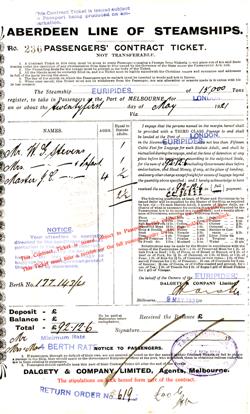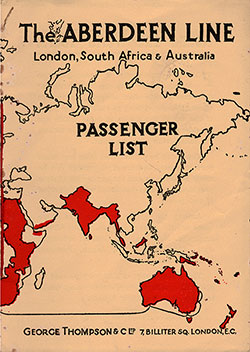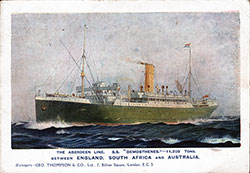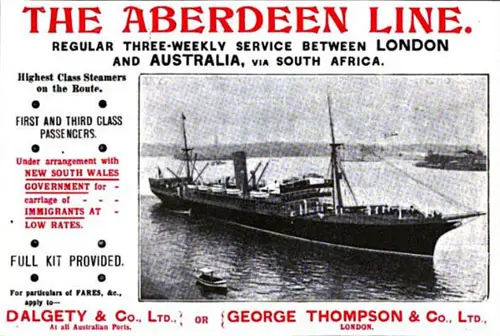Aberdeen Line Archival Collection

The Aberdeen Line, also known as George Thompson & Co., was a British shipping company that operated from the mid-19th century until the 1950s. Established in 1825 by George Thompson, the company initially focused on shipbuilding but soon ventured into the shipping industry, providing passenger and cargo services across various international routes.
Home Port and Ownership
The company's home port was Aberdeen, Scotland, which served as the primary base of operations for the shipping line. George Thompson was the owner and founder of the company. In 1933, the Aberdeen Line was acquired by Shaw, Savill & Albion Co., another prominent British shipping company. However, the Aberdeen Line continued to operate under its own name until the 1950s.
Worldwide Routes
The Aberdeen Line primarily served routes connecting the United Kingdom to Australia and New Zealand, with ships often stopping at intermediate ports such as South Africa, and occasionally South America.
In the early years, the company's ships sailed to Australia via the Cape of Good Hope, but as the Suez Canal opened in 1869, the shipping line began to use this more direct route. Besides serving the UK-Australia route, the Aberdeen Line also had ships operating in the North Atlantic, connecting Britain to North America.
Notable Ships
Some of the most famous ships in the Aberdeen Line fleet include:
- SS Sophocles (1906): One of the company's most advanced ships, equipped with the latest safety and comfort features, such as watertight compartments and wireless communication.
- SS Themistocles (1911): A well-known ship that was used to transport Australian and New Zealand troops during World War I.
The Aberdeen Line ceased operations in the 1950s, as air travel began to replace ocean liners as the preferred method of long-distance passenger transport. However, its legacy remains as an essential part of the maritime history of the United Kingdom, Australia, and New Zealand.

SS Euripides Passage Contract - 21 May 1921
Steamship contract ticket for Third Class Passage on a voyage of the SS Euripides of the Aberdeen Line from Melbourne, Australia to London departing on 21 May 1921.

1925-08-13 SS Sophocles Passenger List
- Steamship Line: Aberdeen Line
- Ship: SS Sophocles
- Class of Passengers: First Class
- Date of Departure: 13 August 1925
- Route: United Kingdom to Australia
- Port of Calls: London to Brisbane via Tenerife, Capetown, Albany, Melbourne, and Sydney
- Commander: Captain A. Ogilvy

1926-01-16 SS Demosthenes Passenger List
- Class of Passengers: Saloon
- Date of Departure: 16 January 1926
- Route: Australia to the United Kingdom via South Africa and Spain
- Port of Calls: Melbourne » Fremantle » Durban » Capetown » Tenerife » Southampton
- Commander: Captain F. A. Orriss

1927-02-13 SS Demosthenes Dinner Menu Post Card
Vintage Dinner Menu Card from 13 February 1927 on board the SS Demosthenes of the Aberdeen Line featured Fried Sole, Tomato Sauce, Roast Sirloin of Beef & Horseradish, and Plum Tart & Cream for dessert. The reverse side contained a daily progress report of distance traveled and weather conditions.
Overview
The Aberdeen Line operated steamships covering the route between London, South Africa, and Australia.
Thompson's Aberdeen Line of steamers is a direct descendant of one of the most famous of the clipper lines. The Aberdeen Line commissioned two magnificent sisters in 1922, Diogenes and Sophocles.
Sophocles was transferred on charter to Shaw, Savill in 1926. Demosthenes followed the current White Star idea of being engined with triple-expansion and a low-pressure turbine.
Bringing Immigrants to Australia via South Africa
The steamships in this line travel via South Africa; the passengers are never subjected to extremes of temperature, and the time of journey if forty-six to fifty days.
Departures from London are at regular three-week intervals, per time-table printed for the whole year, which is strictly adhered to. The accommodation is for first and third-class passengers, and the cabins for the latter, which are either on the upper deck or 'tween decks, are lofty and well lighted.
Passengers are not required to provide anything in the way of bedding, table, or cabin appointments, which are provided by the Line on a very comfortable scale.
As with all the most modern vessels, refrigerator chambers guarantee fresh provisions throughout the voyage, while the general rooms and cabins are lighted throughout with electric light.
A full staff of stewards and stewardesses attend to passengers' comfort, while in the event of sickness, the ship's medical officer attends free of charge, medicines being supplied free, as may be necessary. The ports of call between London and Sydney are Plymouth, Teneriffe, Cape Town, and Melbourne. (Note 1)
The Aberdeen Line was founded in 1824, and long occupied a prominent place in the Australian trade with its fleet of fast-sailing clippers.
The present fleet, however, consists entirely of steamers, and of these, the Themistocles and Demosthenes, of 12,000 tons, are the most famous, the latter being the first turbine steamer trading between England and Australia.
The journey is made around the Cape of Good Hope, and, besides cargo, first- and third-class passengers are carried. (Note 2)

1907 Advertisement for the Aberdeen Line. GGA Image ID # 20b045338c
- Regular Three-Weekly Service Between London and Australia via South Africa
- Highest Class Steamers on the Route
- First and Third Class Passengers
- Under the arrangement with New South Wales Government for the carriage of Immigrants at Low Rates
- Full Kit Provided.
Full particulars of Fares, etc. apply to Dalgety & Co., Ltd at All Australian Ports or George Thompson & Co., Ltd, London.
Information about the Aberdeen Steamship Line
Aberdeen Line operated routes From London and Plymouth to South Africa and Australia. They also offered Round the World Tours and Tours to Victoria Falls and through South Africa.
The fleet of the Aberdeen Line
- SS Euripides, 15,000 Tons Triple Screw
- SS Demosthenes, 11,500 Tons, Triple Screw
- SS Themistocles, 11,500 Tons, Twin Screw
- SS Sophocles, 12,500 Tons, Twin Screw
- SS Diogenes, 12,500 Tons, Twin Screw
Brief History of the Aberdeen Line
George Thompson started a line of vessels to trade between England and Australia, and this service, now called the "Aberdeen Line," is well and honorably known as one of the most efficient lines of vessels afloat. Aberdeen Line (Thompson’s).
This company, plying between London and Australia, via the Cape, founded in Aberdeen in 1824, has occupied for three-quarters of a century a prominent position in the Australian cargo and passenger trade; due in the first instance to the runs of their famous clippers to Melbourne and Sydney.
The Aberdeen, built in 1881, was the first ocean steamer to demonstrate the superior merits of triple expansion engines decisively. The total tonnage now only includes one sailing vessel of 3,093 tons, the old clippers having been replaced by modern steamships.
The Afifhades holds the record from London to Melbourne via the Cape. Her steaming time was 34 days, actual time from port to port 35 days.
History of the Aberdeen Line (1906)
ABERDEEN LINE, between London and Australia via South Africa, is managed by the owners, Messrs. George Thompson & Co. (founded at Aberdeen, Am), who have long occupied a prominent position in the Australian cargo and passenger trades, due to the " runs " of their noted clippers to Melbourne and to Sydney, the general high standard of their fleet, and its exceptional immunity from loss over more than half a century.
Their SS Aberdeen, built in 1881 was the earliest ocean steamer to demonstrate the superior merits of triple-expansion engines decisively.
The total tonnage only includes now one sailing vessel, 2,093 tons, but the reputation of the line is well sustained by modern steam favorites bearing such time-honored names of former "fliers" as Miltiades, Moravian, and Salamis. Two twin-screw steamers, Miltiades, 6,793 tons, and Marathon, 6,772 tons, each 15 knots, have been recently added.
The maiden voyage of the Miltiades from London to Melbourne, took 35 days, her time from Plymouth being a record passage of 34 days steaming.
Fleet, 10 vessels; 44,236 tons.
London Office, 7, Bunter Square, E.C.
Source: Whitaker Almanack by Joseph Whitaker, F.S.A. 1906
Note 1: New South Wales -The Mother State of Australia: A Guide For Immigrants and Settlers, 1906, Issued by The Intelligence Department, Authority of the Government of the State of New South Wales.
Note 2: All About Ships, Second Edition, Lt. Henry Taprell Dorling, R.N., Cassell and Company, Ltd. New York, 1912, Page 141
